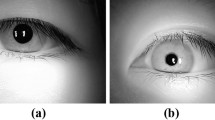Abstract
In order to select as many available irises as possible for recognition through the same indicators, a quality evaluation algorithm for constrained sequence iris is proposed in this paper. In the case where other indicators are set idealization, a variety of iris quality indicators are set from the perspective of sharpness, iris region nature, and offset degree. According to the causal relationship among quality indicators, the order of indicators evaluation will be adjusted, and then a quality decision reasoning process can be formed. The results of experiments used the JLU iris library of Jilin University indicate that the algorithm can effectively improve the survival rate of available iris in the sequence iris and play an active role in improving iris recognition accuracy.
Access this chapter
Tax calculation will be finalised at checkout
Purchases are for personal use only
Similar content being viewed by others
References
Liu, S., Liu, Y., Zhu, X., et al.: Sequence iris quality evaluation algorithm based on morphology and grayscale distribution. J. Jilin Univ. (Sci. Ed.) 56(5), 1156–1162 (2018)
Daugman, J.: Statistical richness of visual phase information update on recognizing persons by iris patterns. Int. J. Comput. Vis. 45(1), 25–38 (2001)
Gao, S., Zhu, X., Liu, Y.: A quality assessment method of iris image based on support vector machine. J. Fiber Bioeng. Inform. 8(2), 293–300 (2015)
Pan, S.: Research on preprocessing algorithm of iris recognition. College of Computer Science and Technology, Jilin University, Changchun, China (2016)
Liu, S., Liu, Y.N., Zhu, X.D., et al.: Iris location algorithm based on partitioning search. Comput. Eng. Appl. 54(18), 212–217 (2018)
Wang, Y., Tan, Y., Tian, J.: A new kind of sharpness evaluation function of image. J. Wuhan Univ. Technol. 29(3), 124–126 (2007)
Liu, S., Liu, Y., Zhu, X., et al.: Iris double recognition based on modified evolutionary neural network. J. Electron. Imaging 26(6), 063023 (2017)
Liu, Y., Liu, S., Zhu, X., et al.: Iris secondary recognition based on decision particle swarm optimization and stable texture. J. Jilin Univ. (Eng. Technol. Ed.) 49(4), 1329–1338 (2019)
Liu, S., et al.: Gabor filtering and adaptive optimization neural network for iris double recognition. In: Zhou, J., et al. (eds.) CCBR 2018. LNCS, vol. 10996, pp. 441–449. Springer, Cham (2018). https://doi.org/10.1007/978-3-319-97909-0_47
JLU Iris Image Database. http://www.jlucomputer.com/index/irislibrary/irislibrary.html
Liu, Y., Liu, S., Zhu, X., et al.: LOG operator and adaptive optimization Gabor filtering for iris recognition. J. Jilin Univ. (Eng. Technol. Ed.) 48(5), 1606–1613 (2018)
Liu, Y.N., Liu, S., Zhu, X.D.: et al. Iris recognition algorithm based on feature weighted fusion. J. Jilin Univ. (Eng. Technol. Ed.) 49(1), 221–229 (2019)
Acknowledgments
The authors would like to thank the referee’s advice and acknowledge the support of the National Natural Science Foundation of China (NSFC) under Grant No. 61471181. Jilin Province Industrial Innovation Special Fund Project under Grant No. 2019C053-2, 2019C053-6. Science and technology project of the Jilin Provincial Education Department under Grant No. JJKH20180448KJ. Thanks to the Jilin Provincial Key Laboratory of Biometrics New Technology for supporting this project.
Author information
Authors and Affiliations
Corresponding author
Editor information
Editors and Affiliations
Rights and permissions
Copyright information
© 2019 Springer Nature Switzerland AG
About this paper
Cite this paper
Shuai, L. et al. (2019). Constrained Sequence Iris Quality Evaluation Based on Causal Relationship Decision Reasoning. In: Sun, Z., He, R., Feng, J., Shan, S., Guo, Z. (eds) Biometric Recognition. CCBR 2019. Lecture Notes in Computer Science(), vol 11818. Springer, Cham. https://doi.org/10.1007/978-3-030-31456-9_38
Download citation
DOI: https://doi.org/10.1007/978-3-030-31456-9_38
Published:
Publisher Name: Springer, Cham
Print ISBN: 978-3-030-31455-2
Online ISBN: 978-3-030-31456-9
eBook Packages: Computer ScienceComputer Science (R0)




